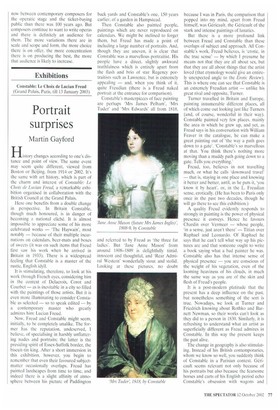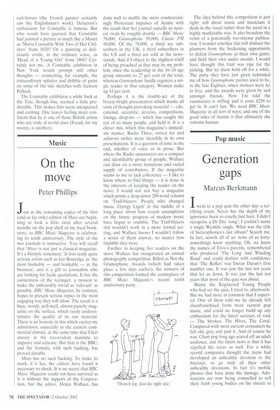Exhibitions
Constable: Le Choix de Lucian Freud (Grand Palais, Paris, till 13 January 2003)
Portrait surprises
Martin Gayford
History changes according to one's distance and point of view. The same event may seem quite different, viewed from Boston or Beijing, from 1914 or 2002. It's the same with art history, which is part of the charm and interest of Constable: Le Choir de Lucian Freud, a remarkable exhibition organised in collaboration with the British Council at the Grand Palais.
Here one benefits from a double change in perspective. In Britain Constable, though much honoured, is in danger of becoming a national cliché. It is almost impossible to appreciate some of his more celebrated works — 'The Haywain', most notably — because of their multiple incarnations on calendars, beer-mats and boxes of sweets (it was on such items that Freud first saw his work when he arrived in Britain in 1933). There is a widespread feeling that Constable is a master of the rustic. English idyll.
It is stimulating, therefore, to look at his work through French eyes, considering him in the context of Delacroix, Corot and Courbet — as is inevitable in a city so filled with the paintings of those artists. But it is even more illuminating to consider Constable as selected — so to speak edited — by a contemporary master who greatly admires him: Lucian Freud.
Now, Freud and Constable might seem, initially, to be completely unalike. The former has the reputation, undeserved, I believe, of specialising in harshly unflattering nudes and portraits; the latter is the presiding spirit of Essex-Suffolk border, the biscuit-tin king. After a short immersion in this exhibition, however, you begin to remember that even their favoured subjectmatter occasionally overlaps. Freud has painted landscapes from time to time, and indeed there is a slight affinity of atmosphere between his picture of Paddington back yards and Constable's one, 150 years earlier, of a garden in Hampstead.
Then Constable also painted people, paintings which are never reproduced on calendars. We might be inclined to forget them, but Freud has made a point of including a large number of portraits. And, though they are uneven, it is clear that Constable was a marvellous portraitist. His people have a direct, slightly awkward truthfulness which is entirely apart from the flash and brio of star Regency portraitists such as Lawrence, but is extremely appealing — and, when you think of it, quite Freudian (there is a Freud naked portrait at the entrance for comparison).
Constable's masterpieces of face painting are perhaps 'Mrs James Pelham', 'Mrs Tuder' and 'Mrs Edwards' all from 1818, and referred to by Freud as 'the three fat ladies'. But 'Jane Anne Mason' from around 1808-1809 is delightfully timid, innocent and thoughtful, and 'Rear Admiral Western' wonderfully stout and stolid. Looking at these pictures, no doubt because I was in Paris, the comparison that popped into my mind, apart from Freud himself, was Gericault, the Gericault of the stark and intense paintings of lunatics.
But there is a more profound link between Freud and Constable than these overlaps of subject and approach. All Constable's work, Freud believes, is 'erotic, in the true sense' — by which I presume he means not that they are all about sex, but that they are all about things that the artist loved (that etymology would give an entirely unexpected angle to the Erotic Review). This is where one can see that Constable is an extremely Freudian artist — unlike his great rival and opposite, Turner.
Turner travelled in Britain and Europe, painting innumerable different places, all of which come out looking just like Turners (and, of course, wonderful in their way). Constable painted very few places, mainly the area in which he grew up, and yet, as Freud says in his conversation with William Feaver in the catalogue, he can make a great painting out of 'the way a path goes down to a gate'. 'Constable's so marvellous at that. You think there's nothing more moving than a muddy path going down to a gate. Tells you everything.'
Freud, too, believes in not travelling much, or what he calls 'downward travel' — that is, staying in one place and knowing it better and better, until, as he puts it, 'you know it by heart', or, in the L. Freudian sense, erotically. (He has been to Paris only once in the past two decades, though he will go there to see this exhibition.) A quality Freud evidently responds to strongly in painting is the power of physical presence it conveys. Hence he favours Chardin over Vermeer — whose people, 'in a sense, just aren't there' — Titian over Raphael and Leonardo. Of Raphael he says that he can't tell what way up his pictures are and that someone ought to write a book saying what a bad painter he was. Constable also has that intense sense of physical presence — you are conscious of the weight of his vegetation, even of the looming heaviness of his clouds, in much the same way as you are of the skin and flesh of Freud's people.
It is a post-modern platitude that the present has a deep influence on the past, but nonetheless something of the sort is true. Nowadays, we look at Turner and Friedrich knowing about Rothko and Barnett Newman, so their works can't look as they did to a person in 1830. Similarly, it is refreshing to understand what an artist as superficially different as Freud admires in Constable. In this way the present keeps the past alive.
The change in geography is also stimulating. Instead of his British contemporaries, whom we know so well, you suddenly think of Constable in a Parisian context. Gericault seems relevant not only because of his portraits but also because the fearsome horses and carts of his English period echo Constable's obsession with wagons and cart-horses (the French painter certainly saw the Englishman's work). Delacroix's enthusiasm for Constable is famous. But who would have guessed that Constable had painted a picture as much like a Manet as 'Maria Constable With Two of Her Children' from 1820? Or a painting as deliciously erotic, in the ordinary sense, as 'Head of a Young Girl' from 1806? Certainly not me. A Constable exhibition in New York would prompt still other thoughts — connecting, for example, the extraordinary splatter and dribble of paint on some of the late sketches with Jackson Pollock.
The Constable exhibition a while back at the Tate, though fine, seemed a little predictable. This makes him seem unexpected and exciting. One leaves feeling more confident that he is one of those British artists who are truly of world class (Freud, for my money, is another).



































































































 Previous page
Previous page